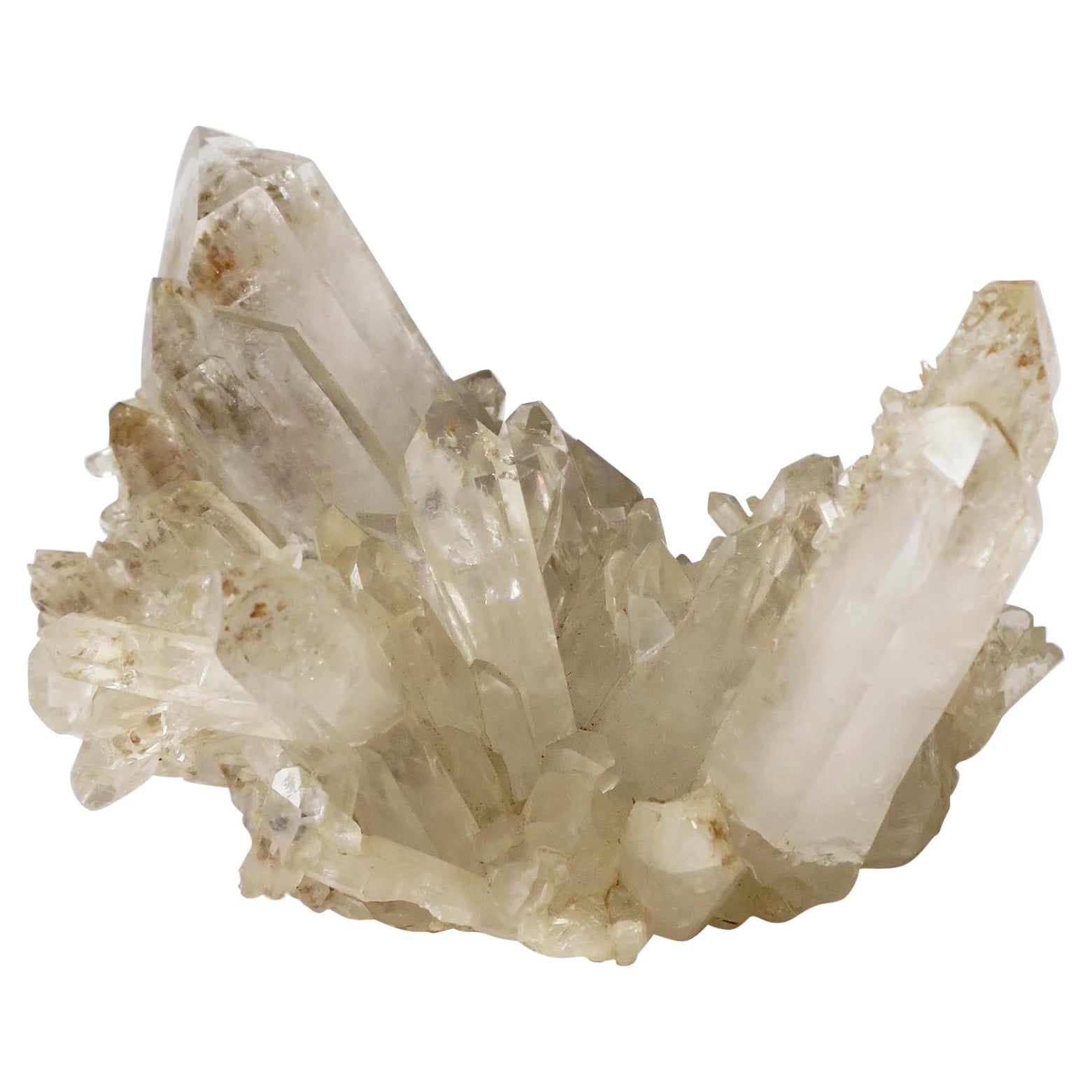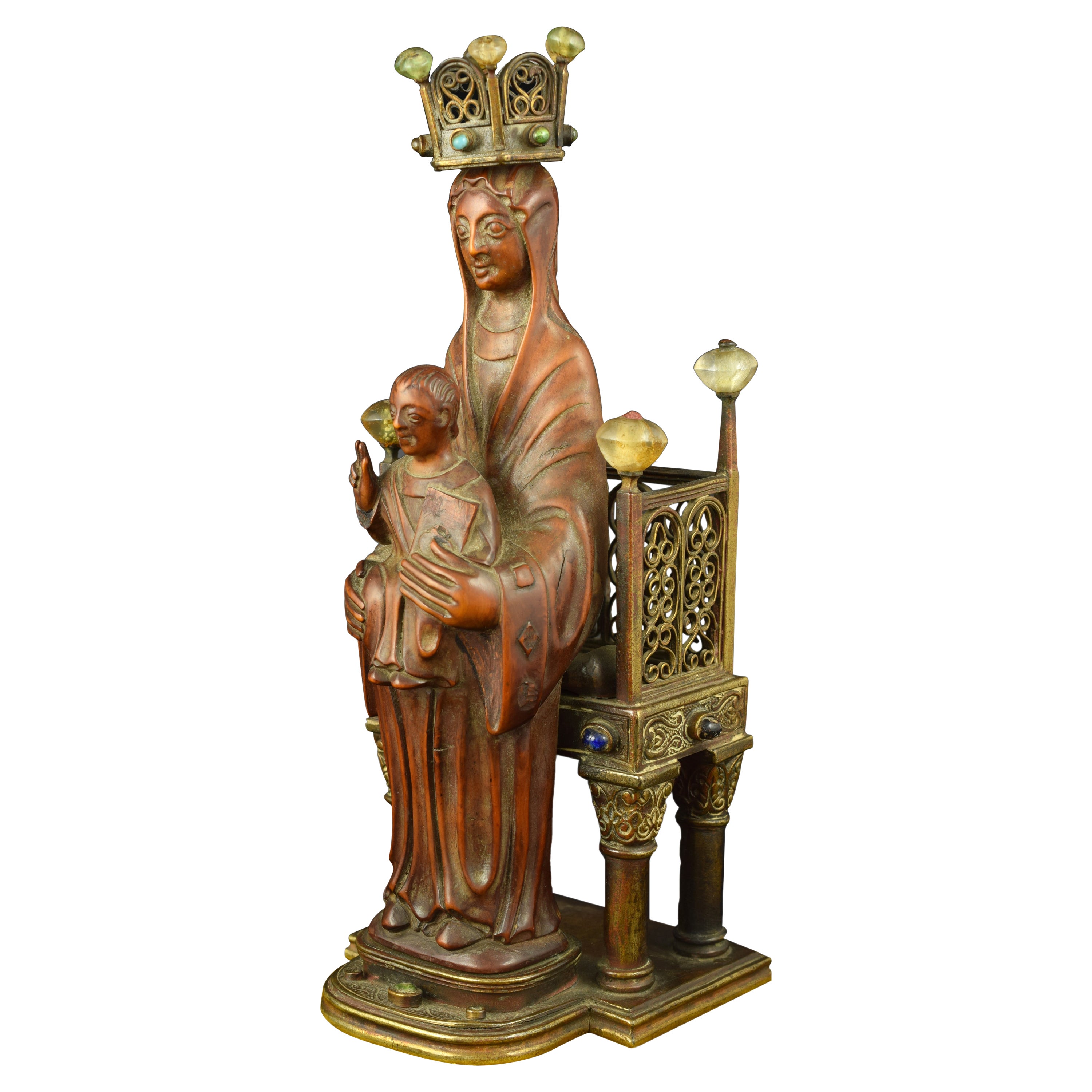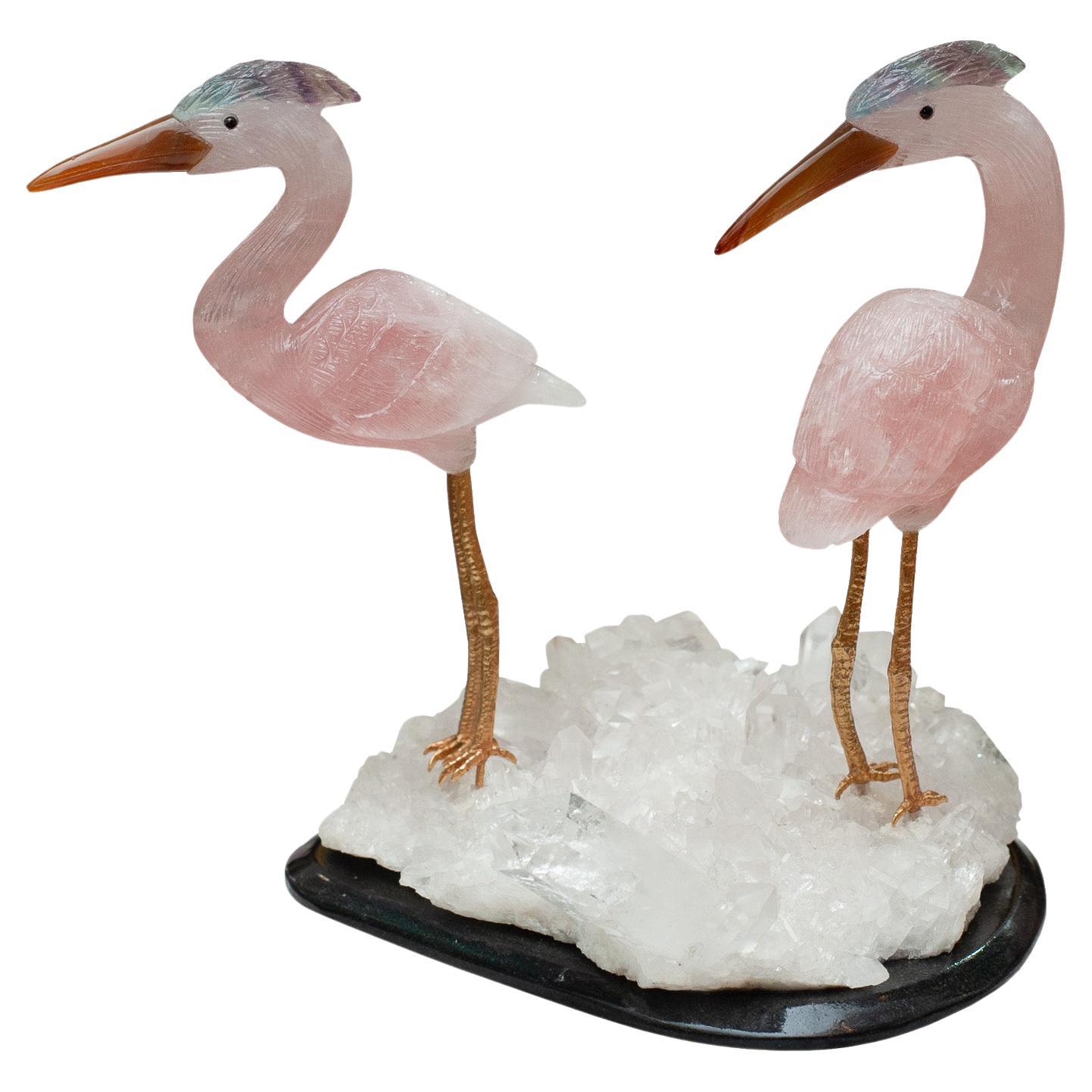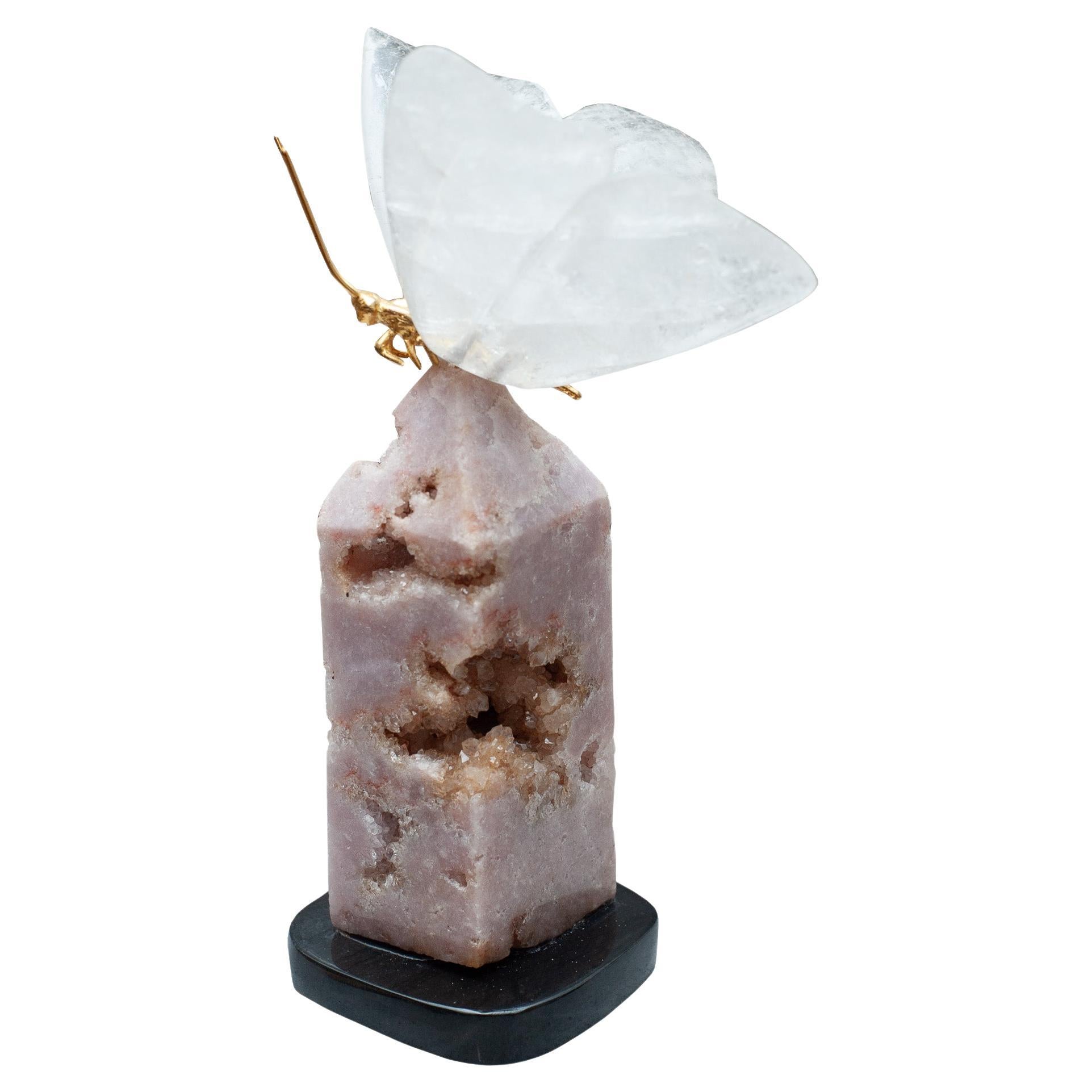Items Similar to Enamel Gold and Rock Crystal Figure of Emperor Maximilian I by Reinhold Vasters
Want more images or videos?
Request additional images or videos from the seller
1 of 11
Enamel Gold and Rock Crystal Figure of Emperor Maximilian I by Reinhold Vasters
About the Item
A rare enamel, gold and rock crystal figure of Emperor Maximilian I by Reinhold Vasters, Aachen,
In the Renaissance style, circa 1870.
The gold figure in bright enameled priestly clothing, wearing the Habsburg imperial crown, with orb and scepter on his enameled hands, standing on a rock crystal base.
The rock crystal base marked: "Maximilianus I. MCCCCXCIII" [1493]
Apparently unmarked
Measures: Height 9.5 in high
A true museum masterpiece. A rare opportunity to own this wonderful object.
Literature:
Miriam Krautwurst, Reinholt Vasters: Ein nederrheinischer Goldschmied des 19. Jahrhunderts in der Tradition alter Meister. Sein Zeichnungskonvolut im Victoria and Albert Museum, Trier (University doctoral thesis), 2003
About Reinhold Vasters:
Vasters was the son of a locksmith, and in 1853 entered his maker’s mark as a goldsmith in Aachen, near his birthplace. The same year he was appointed restorer to the Aachen Cathedral treasury, and became known as a maker of church plate in gothic style. However, it was his work in the Renaissance style which brought him prosperity, and later notoriety. In association with the Vienna-born Paris dealer Frédéric Spitzer, he enhanced incomplete or damaged early works of art, or created them whole-cloth based on early examples. Spitzer sold these on to the major collectors of the 1870s and 1880s, particularly members of the Rothschild family. After Spitzer’s death in 1890, his collection (including remaining stock) was luxuriously published then dispersed by auction, with many pieces finding their way to American collectors such as J.P. Morgan, Benjamin Altman, and Henry Walters.
Long accepted as antiques, Vasters’ works have been recently identified through a group of drawings preserved at the Victoria and Albert Museum. Sold at Vasters posthumous sale in Aachen in 1909, they were given to the V&A in 1919. From these, many Vasters’creations, probably in association with Spitzer and the goldsmith Alfred André, have been identified, including thirty pieces in the Metropolitan Museum (Yvonne Hackenbroch, “Reinhold Vasters, Goldsmith” Metropolitan Museum of Art Journal 19/20 (1986), p. 164).
From his beginnings at the Cathedral Treasury, repairing and reworking genuine ancient items was one of Vasters’ specialties. Contemporary accounts credited Spitzer with persuading clergy to sell him old liturgical items cheaply, because of damage and wear, while offering to replace them with new creations in “historical” styles that would better suit contemporary religious practice (ibid. p. 169). When Vasters loaned almost 500 pieces from his own collection to a Kunsthistorische Ausstellung in Düsseldorf in 1902, the group included fractured rock crystal vessels and orphan lids and pedestals. These suggest less a finished “collection” than the contents of a workshop, the antique raw material around which to create a finished complete item for Spitzer's clientele. Ms. Hackenbroch’s study of Vasters’ work distinguishes between “gold-mounted rock crystals of sixteenth and seventeenth-century origin” and those of nineteenth-century origin, and this divide is echoed in the character of the V&A drawings; there are fewer whole designs than there are small, exquisitely rendered details, suggesting enhancements to existing forms.
The drawings associated with the offered lot are a case in point. First published by Miriam Krautwurst in her 2003 doctoral thesis, these beautifully colored designs show the attributes held by each figure, and designs for the two patterns of wings. The figures, whose origins will be considered in the next section, were the sort of fragments with which Spitzer and Vasters excelled. Their poses required pedestals; they were supplied in richly colored lapis lazuli, enhanced by enameled gold moldings. Their open and outstretched hands required objects; rather than the religious emblems that they probably originally held, a secular program was developed – perhaps to better appeal to non-Catholic or Jewish collectors.
- Dimensions:Height: 9 in (22.86 cm)Width: 3 in (7.62 cm)Depth: 2 in (5.08 cm)
- Style:Renaissance (In the Style Of)
- Materials and Techniques:
- Place of Origin:
- Period:
- Date of Manufacture:circa 1870
- Condition:
- Seller Location:New York, NY
- Reference Number:1stDibs: f179821710278904663fs
About the Seller
5.0
Vetted Seller
These experienced sellers undergo a comprehensive evaluation by our team of in-house experts.
Established in 1980
1stDibs seller since 2016
58 sales on 1stDibs
Typical response time: <1 hour
- ShippingRetrieving quote...Ships From: New York, NY
- Return PolicyThis item cannot be returned.
More From This SellerView All
- Rare and Important Italian White Marble Bust Sculpture of Jesus Christ, C. 1850Located in New York, NYRare and important Italian white marble bust sculpture of Jesus Christ, C. 1850. A truly exceptionally carved marble relief of Holy Jesus Christ. ...Category
Antique 19th Century Italian Renaissance Busts
MaterialsMarble
- Large and Rare Patinated Bronze Bust of George Washington, by F. BarbedienneBy F. Barbedienne FoundryLocated in New York, NYA Large and Rare Patinated Bronze Bust of George Washington, after Houdon by F. Barbedienne Foundry, circa 1870. Very nice quality green patinated bronze bust of President...Category
Antique 19th Century French American Classical Busts
MaterialsBronze
- Rare Italian White Marble Relief of "Young Saint John the Baptist" circa 1860By Desiderio da SettignanoLocated in New York, NYA Rare Italian White Marble Relief of "Young Saint John the Baptist" circa 1860 after Desiderio Da Settignano. The original pietra serena relief by Desiderio Da Settignano, is in ...Category
Antique 19th Century Italian Renaissance Figurative Sculptures
MaterialsMarble
- Mellerio Paris, A French Gold, Diamonds, Silver, and Smoky Quartz Carved HorseBy MellerioLocated in New York, NYMellerio Paris, A French Gold, Diamonds, Silver-Gilt, Rock-Crystal, Jade, Mother-Of-Pearl and Smoky Quartz, Carved Horse Sculpture, Jeweled Mounted Object. An extremely rare and unique, one of a kind French gold, diamonds, Silver-gilt, rock-crystal, jade, obsidian, mother-of-pearl, and smoky quartz carved jeweled sculpture "CHEVAUX DE LEGENDE", "A Legendary Horse" by Mellerio, Paris, circa 1991. Sitting on black obsidian base, the solid rock-crystal slab is finely applied with a carved smoky -quartz and jade horse with a harness mounted in 18k gold, brilliant -cut diamonds, rubies, turquoise, and amethyst chains and pendants. The top columns adorned with 18k gold and brilliant cut diamond pendants, the bottom with gold and mother of pearl plaques. The obsidian base with a plaque engraved: CHEVAUX DE LEGENDE" / N° 05 / MELLERIO DITS MELLER / PARIS / 5003 D The piece is in excellent condition and comes with a custom made wood case made for transport. It's very elegant and has French hallmarks throughout. A truly magnificent piece. Measures 10.5" high x 8.5" wide x 4" deep Founded in France in 1613 by the descendants of Italian immigrants from the Vigezzo Valley in the north of Italy, Mellerio is one of the oldest jewellery houses in Europe. The family business soon attracted the attention of the Royal Court and Marie Antoinette herself reportedly purchased a precious bracelet featuring 7 cameos surrounded by rubies in 1780. Later on, in the 19th century, Mellerio became the official supplier of the French Royal family and the Court of Netherland. Mellerio creates many jewellery items, all set with rare gems such as peridots, amethysts, aquamarines, citrines and topaz, applying for a patent, the flexible stem, a very supple and light jewellery mechanism. Mellerio remains also well known for their spectacular series of Art Nouveau jewels, created at the beginning of the 20th century, as well as for the creation of trophies rewarding some of the greatest footfall and tennis players of history. In 1993, the jewellery house launched their first watch collection. Today, Mellerio has stores in Paris, Japan and Hong Kong. July 14, 1789: this date is known throughout the world as the beginning of the French Revolution. According to a ledger belonging to House of Mellerio, this was also the day that the jeweler sold a golden key to the Comte de Coutance for 10 livres. This ledger, as well as inventories dating as far back as 1768, are the jeweler’s oldest archives. These archives have continued to grow over the years, as the House, established on rue de la Paix in Paris, still lives on today, still in the hands of the same family from Craveggia, in the North of Italy. The tumultuous history of the Mellerio family in France probably goes as far back as the Italian wars of the Renaissance, but the first official document proving their commercial activity in Paris dates back to 1613. This document is the famous royal warrant awarded by Marie de Medici to a number of Italian families established along the rue des Lombards, including the Mellerios, allowing them to sell “small jewelery items”, therefore granting them a small exception to the traditional monopoly enjoyed by Parisian jewelers. At that time, powerful corporations regulated the operations and customs of Parisian business, but thanks to this exceptional warrant, the Mellerios managed to escape the confines of this framework. Today, this wax-sealed document is kept at the city hall of Craveggia. From 1613 to the Revolution, the Mellerios lived between France and Italy. The corporations tried many times to put an end to their trade privileges, but all in vain, as a dynasty of sovereigns renewed the warrant. Always marrying and often retiring in Craveggia, the Mellerios continued to maintain their jewelry business in Paris. At first, they did this without a shop. Wearing backpacks (wooden boxes divided into small compartments where jewels were kept), they would tour town fairs around Paris and royal castles. This is how Jean-Baptiste Mellerio (1765-1850) is said to have sold a bracelet set with rubies and Antique cameos to Marie-Antoinette, which still exists today. Many elements seem to prove the veracity of this anecdote. The queen was particularly fond of cameos, which cover the entire background of her famous jewelry cabinet, and ruby was her favorite stone after diamond. The famous bracelet, reacquired a few years ago by the House of Mellerio, is indeed an 18th century jewel, set with antique cameos representing the profiles of Roman emperors. Two branches of the family were operating in Paris during this time, under the reign of Louis XVI: that of Jean-François (1746-1828), the paternal ancestor of the current Mellerios, and that of Jean-Baptiste (1765-1850). The French Revolution forced them to return to Italy. However, both Jean-Baptiste and François Mellerio (1772-1843), who was the son of Jean-François, were eventually able to return to Paris after the founding of the Consulate. Jean-Baptiste opened a shop at the Iron Crown of rue Vivienne, and François opened his at the Palais des Tuileries, rue du Coq Saint-Honoré. His well-organized order books give an idea of his high-ranking clientele during the “Old Regime”, among which were the Comte and Comtesse Octave de Segur, the Marquise (later Duchess) de Tourzel, former governess of the royal children, and her daughter, the Comtesse de Bearn, the Craufurds -who organized the flight to Varennes, the Duc and Duchess de Gramont, the Comtesse de Boigne, and Madame de Souza, Talleyrand’s mistress. We also see the names of the imperial family: Empress Josephine, the Queen of Holland, Princess Elisa, Caroline and Pauline. At that time, the House of Mellerio specialized, among other things, in the trade of antique cameos, a newly fashionable genre of jewel that captured the imagination of all the princesses and noble women of the time. The years of the Restauration and July Monarchy were among the most glorious. The Bourbons were back on the throne, and the clientele of the House of Mellerio had regained its former wealth. Mellerio supplied Louis-Philippe, Duke of Orléans, as well as his mother, wife and sister, with sumptuous jewels, including a set of emeralds made piece by piece, while the Duke of Bourbon, last prince of the House of Condé, offered diamonds to his mistress, the scheming Baronne de Feucheres, and Monsieur de LaFayette also bought cameos for one of his granddaughters. For the first time, Mellerio ventured into the world of arts in 1815, when Carlotta Grisi, a famous dancer who created Giselle, as well as an actress named Rachel, bought jewels at the Mellerio store on rue de la Paix. 1848 marked a new turning point. France once again became a Republic. François Mellerio handed the company over to his son, Jean, and the latter decided to travel to Spain to build a new clientele. He later became one of the jewelers of the royal family, and met Eugénie de Montijo, who remained a faithful client when she became empress of the French people. The Imperial years were lavish. During the Second Empire, Paris was a pageant of crinoline dresses designed by Worth, while jewels by Mellerio, Worth’s neighbour on the rue de la Paix, adorned the noble women of the Tuileries court. The Empress bought pearls. Mathilde Bonaparte...Category
20th Century French Mounted Objects
MaterialsJade, Quartz, Rock Crystal, Gold, Silver
- Rare Patinated Bronze Sculpture of Benjamin Franklin, by A. Carrier-BelleuseBy Albert-Ernest Carrier-BelleuseLocated in New York, NYAlbert-Ernest Carrier-Belleuse (France, 1824-1887) A rare seated bronze statue of Benjamin Franklin holding his walking stick and hat, with a book in his ri...Category
Antique 19th Century French American Classical Figurative Sculptures
MaterialsBronze
- Rare and Important Italian Alabaster Bust Sculpture of Jesus Christ, C. 1860Located in New York, NYA rare and important Italian alabaster bust sculpture of Jesus Christ, C. 1860 A modeled bust of Holy Christ wearing a crown of thorns, excep...Category
Antique 19th Century Italian Baroque Busts
MaterialsAlabaster
You May Also Like
- Natural Rock Crystal Specimen PieceLocated in New York, NYA rock crystal natural specimen piece aka clear quartz, decorative object. Dimensions: 3.5" D x 4.25" W.Category
20th Century Unknown Organic Modern Natural Specimens
MaterialsQuartz, Rock Crystal
- Italian Renaissance Painted Lifesize Figure of Religious ScholarLocated in New York, NYItalian Renaissance painted pine lifesize figure of religious scholar holding book,17th or 18th century.Category
Antique Mid-17th Century Italian Renaissance Religious Items
MaterialsPine
- Virgin with Child Enthroned, Boxwood, Bronze and Carved Rock Crystal, 19th CLocated in Madrid, ESVirgin with Child enthroned. Boxwood, bronze and carved rock crystal. XIX century. On an upholstered base, another second base has been placed in bronze, the metal in which the throne is made. It stands on four low columns...Category
Antique 19th Century Spanish Neoclassical Revival Religious Items
MaterialsRock Crystal, Bronze, Other
- Rose Quartz Hummingbird Pair Sculpture on Rock Crystal and Marble Mineral BaseLocated in Toronto, ONA beautiful hand carved semi precious rose quartz stone hummingbird pair, with brass beak and feet, mounted on a rock crystal quartz and green marble...Category
2010s Brazilian Animal Sculptures
MaterialsMulti-gemstone, Quartz
- Rose Quartz Crane Pair Sculpture on Rock Crystal and Black Marble Mineral BaseLocated in Toronto, ONA beautiful hand carved semi precious rose quartz stone crane pair, with carnelian beaks, fluorite crests, and brass legs. The pair of cranes are mounted on a rock crystal quartz min...Category
2010s Brazilian Animal Sculptures
MaterialsMulti-gemstone, Quartz
- Rock Crystal Butterfly Sculpture on Pink Geode Obelisk BaseLocated in Toronto, ONA stunning decorative mineral specimen, composed of a rock crystal butterfly with brass body, on a pink geode obelisk on black marble base. A beautiful acc...Category
2010s Brazilian Animal Sculptures
MaterialsQuartz, Stone
Recently Viewed
View AllMore Ways To Browse
Completed Items
Cloth Of Gold
Antique Religious Objects
American Gothic Furniture
Rock And Sons
Antique Crystal Marks
Imperial Enamel
Room Divider Gold
Antique Small Decorative Plates
Enamel Wings
Imperial Germany
Imperial German
Rock And Gold Creations
Antique Figure Drawing
German Renaissance Furniture
Standing Room Divider
Rock Crystal Gold Antique
Standing Crystal





